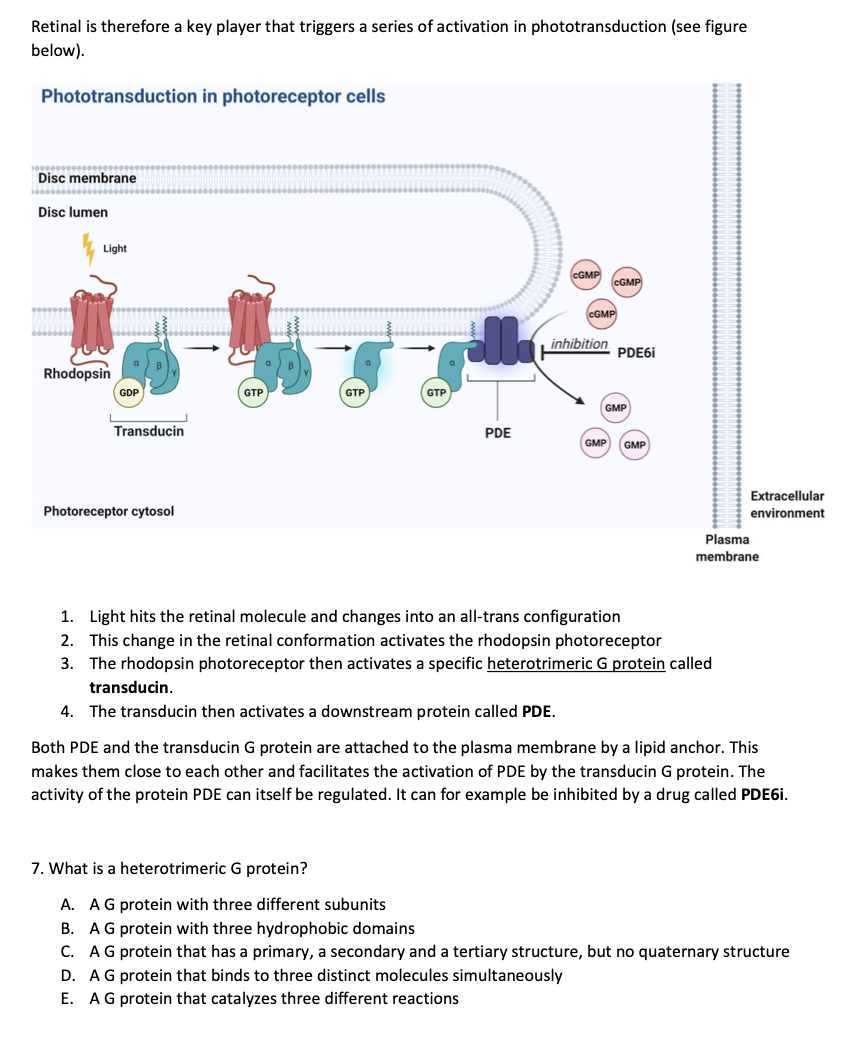Retinal is therefore a key player that triggers a series of activation in phototransduction (see figure below). Phototransduction in photoreceptor cells **************** Disc membrane 100000000000000 Disc lumen Light Rhodopsin GDP Transducin Photoreceptor cytosol GTP GTP GTP PDE CGMP CGMP inhibition CGMP GMP PDE6i GMP GMP Extracellular environment Plasma membrane 1. Light hits the retinal molecule and changes into an all-trans configuration 2. This change in the retinal conformation activates the rhodopsin photoreceptor 3. The rhodopsin photoreceptor then activates a specific heterotrimeric G protein called transducin. 4. The transducin then activates a downstream protein called PDE. Both PDE and the transducin G protein are attached to the plasma membrane by a lipid anchor. This makes them close to each other and facilitates the activation of PDE by the transducin G protein. The activity of the protein PDE can itself be regulated. It can for example be inhibited by a drug called PDE6i. 7. What is a heterotrimeric G protein? A. AG protein with three different subunits B. AG protein with three hydrophobic domains C. A G protein that has a primary, a secondary and a tertiary structure, but no quaternary structure D. A G protein that binds to three distinct molecules simultaneously E. A G protein that catalyzes three different reactions
Retinal is therefore a key player that triggers a series of activation in phototransduction (see figure below). Phototransduction in photoreceptor cells **************** Disc membrane 100000000000000 Disc lumen Light Rhodopsin GDP Transducin Photoreceptor cytosol GTP GTP GTP PDE CGMP CGMP inhibition CGMP GMP PDE6i GMP GMP Extracellular environment Plasma membrane 1. Light hits the retinal molecule and changes into an all-trans configuration 2. This change in the retinal conformation activates the rhodopsin photoreceptor 3. The rhodopsin photoreceptor then activates a specific heterotrimeric G protein called transducin. 4. The transducin then activates a downstream protein called PDE. Both PDE and the transducin G protein are attached to the plasma membrane by a lipid anchor. This makes them close to each other and facilitates the activation of PDE by the transducin G protein. The activity of the protein PDE can itself be regulated. It can for example be inhibited by a drug called PDE6i. 7. What is a heterotrimeric G protein? A. AG protein with three different subunits B. AG protein with three hydrophobic domains C. A G protein that has a primary, a secondary and a tertiary structure, but no quaternary structure D. A G protein that binds to three distinct molecules simultaneously E. A G protein that catalyzes three different reactions
Biology: The Unity and Diversity of Life (MindTap Course List)
14th Edition
ISBN:9781305073951
Author:Cecie Starr, Ralph Taggart, Christine Evers, Lisa Starr
Publisher:Cecie Starr, Ralph Taggart, Christine Evers, Lisa Starr
Chapter33: Sensory Perception
Section: Chapter Questions
Problem 4DAA: Occupational Hearing Loss Frequent exposure to loud noise of a particular pitch can cause loss of...
Related questions
Question

Transcribed Image Text:Retinal is therefore a key player that triggers a series of activation in phototransduction (see figure
below).
Phototransduction in photoreceptor cells
Disc membrane
1000000000………………………….
Disc lumen
Light
Rhodopsin
GDP
Transducin
Photoreceptor cytosol
GTP
GTP
GTP
PDE
CGMP
CGMP
inhibition
CGMP
GMP
PDE6i
GMP
GMP
Extracellular
environment
Plasma
membrane
1. Light hits the retinal molecule and changes into an all-trans configuration
2. This change in the retinal conformation activates the rhodopsin photoreceptor
3. The rhodopsin photoreceptor then activates a specific heterotrimeric G protein called
transducin.
4. The transducin then activates a downstream protein called PDE.
Both PDE and the transducin G protein are attached to the plasma membrane by a lipid anchor. This
makes them close to each other and facilitates the activation of PDE by the transducin G protein. The
activity of the protein PDE can itself be regulated. It can for example be inhibited by a drug called PDE6i.
7. What is a heterotrimeric G protein?
A. A G protein with three different subunits
B. A G protein with three hydrophobic domains
C. A G protein that has a primary, a secondary and a tertiary structure, but no quaternary structure
D. A G protein that binds to three distinct molecules simultaneously
E. AG protein that catalyzes three different reactions
Expert Solution
This question has been solved!
Explore an expertly crafted, step-by-step solution for a thorough understanding of key concepts.
Step by step
Solved in 4 steps

Knowledge Booster
Learn more about
Need a deep-dive on the concept behind this application? Look no further. Learn more about this topic, biology and related others by exploring similar questions and additional content below.Recommended textbooks for you

Biology: The Unity and Diversity of Life (MindTap…
Biology
ISBN:
9781305073951
Author:
Cecie Starr, Ralph Taggart, Christine Evers, Lisa Starr
Publisher:
Cengage Learning

Human Physiology: From Cells to Systems (MindTap …
Biology
ISBN:
9781285866932
Author:
Lauralee Sherwood
Publisher:
Cengage Learning

Biology 2e
Biology
ISBN:
9781947172517
Author:
Matthew Douglas, Jung Choi, Mary Ann Clark
Publisher:
OpenStax

Biology: The Unity and Diversity of Life (MindTap…
Biology
ISBN:
9781305073951
Author:
Cecie Starr, Ralph Taggart, Christine Evers, Lisa Starr
Publisher:
Cengage Learning

Human Physiology: From Cells to Systems (MindTap …
Biology
ISBN:
9781285866932
Author:
Lauralee Sherwood
Publisher:
Cengage Learning

Biology 2e
Biology
ISBN:
9781947172517
Author:
Matthew Douglas, Jung Choi, Mary Ann Clark
Publisher:
OpenStax


Biology (MindTap Course List)
Biology
ISBN:
9781337392938
Author:
Eldra Solomon, Charles Martin, Diana W. Martin, Linda R. Berg
Publisher:
Cengage Learning

Biology: The Dynamic Science (MindTap Course List)
Biology
ISBN:
9781305389892
Author:
Peter J. Russell, Paul E. Hertz, Beverly McMillan
Publisher:
Cengage Learning